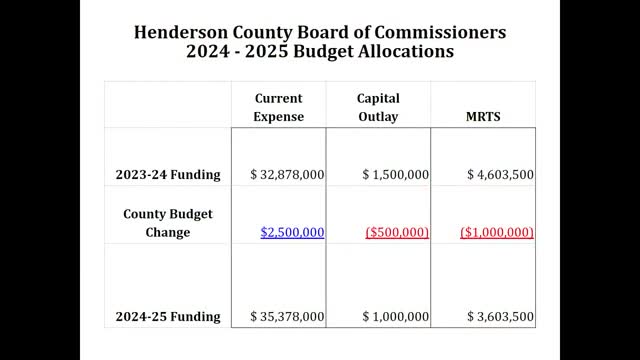Budget Crisis Averted as Schools Secure Essential Funding
June 28, 2024 | Henderson County Schools, School Districts, North Carolina

This article was created by AI summarizing key points discussed. AI makes mistakes, so for full details and context, please refer to the video of the full meeting. Please report any errors so we can fix them. Report an error »

During a recent government meeting, significant discussions centered around the district's budget allocations and the implications of state funding on local educational services. The current expense line item is set to increase by $2.5 million, bringing it to approximately $35.4 million. This adjustment comes from a reduction in capital funding, which has been decreased from $1.5 million to $1 million, alongside a reallocation of $1 million from the MRTS budget.
The meeting highlighted the importance of flexibility in budget management, particularly as the district prepares for the upcoming fiscal year. The total allocation from the board of commissioners, excluding debt service, is projected to exceed $50 million, with a fund balance estimate of $5.28 million available for operational needs.
Key proposals discussed included maintaining five social worker positions and increasing the coaching scale by 1%. The estimated cost for these initiatives totals approximately $551,000. The leadership team emphasized the necessity of these roles to support students effectively, suggesting a time-bound approach for the social worker positions to allow for future budget evaluations.
Concerns were raised regarding potential increases in teacher salaries mandated by the state, which could further strain the budget. The general assembly's discussions on salary raises remain uncertain, with implications that could add an additional $1 million to the district's expenses.
The board acknowledged the need for careful financial planning, particularly in light of recurring costs associated with the proposed social worker positions and coaching scale increase. The leadership team is tasked with exploring funding partnerships and alternative solutions to sustain these essential services without compromising the district's financial stability.
Overall, the meeting underscored the ongoing challenges of balancing educational funding with operational needs, as the district navigates a complex financial landscape influenced by state mandates and local budgetary constraints.
The meeting highlighted the importance of flexibility in budget management, particularly as the district prepares for the upcoming fiscal year. The total allocation from the board of commissioners, excluding debt service, is projected to exceed $50 million, with a fund balance estimate of $5.28 million available for operational needs.
Key proposals discussed included maintaining five social worker positions and increasing the coaching scale by 1%. The estimated cost for these initiatives totals approximately $551,000. The leadership team emphasized the necessity of these roles to support students effectively, suggesting a time-bound approach for the social worker positions to allow for future budget evaluations.
Concerns were raised regarding potential increases in teacher salaries mandated by the state, which could further strain the budget. The general assembly's discussions on salary raises remain uncertain, with implications that could add an additional $1 million to the district's expenses.
The board acknowledged the need for careful financial planning, particularly in light of recurring costs associated with the proposed social worker positions and coaching scale increase. The leadership team is tasked with exploring funding partnerships and alternative solutions to sustain these essential services without compromising the district's financial stability.
Overall, the meeting underscored the ongoing challenges of balancing educational funding with operational needs, as the district navigates a complex financial landscape influenced by state mandates and local budgetary constraints.
View full meeting
This article is based on a recent meeting—watch the full video and explore the complete transcript for deeper insights into the discussion.
View full meeting
